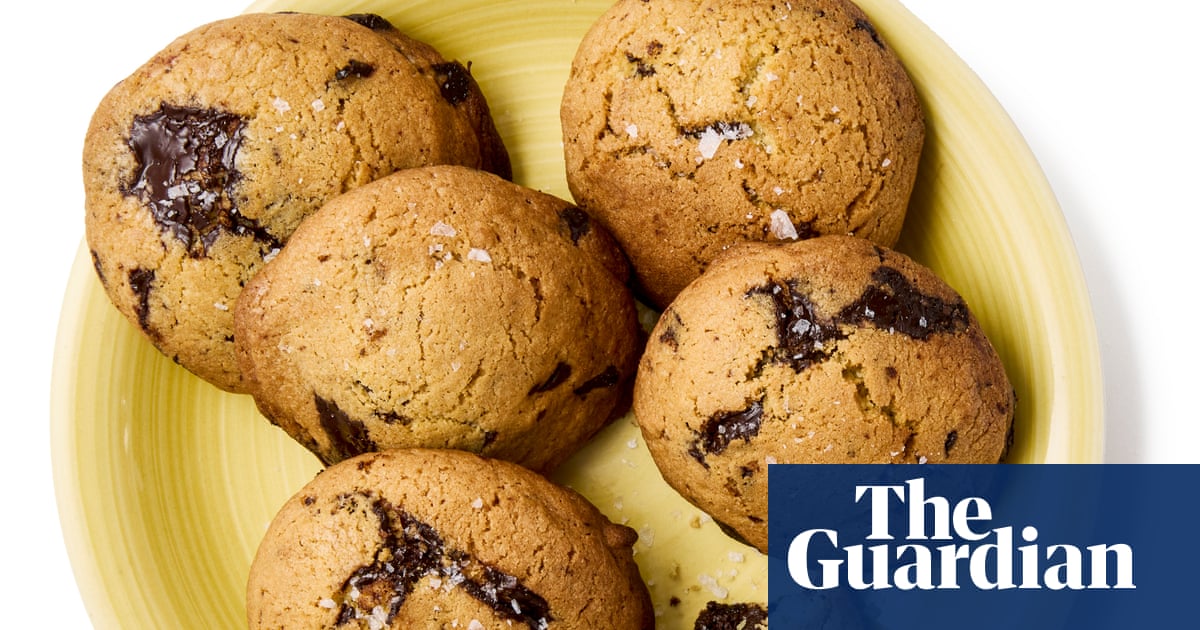Once upon a time, not so long ago, the only so-called chocolate chip cookies on offer in the UK were, in fact, biscuits – small, brittle ones peppered with tiny, waxy, cocoa-coloured pellets. When I finally discovered the soft, chewy American originals in a subterranean outlet at Birmingham New Street station, my teenage mind was officially blown. These are even better.
Prep25 min, plus chillingCook15 minMakes15
120g room-temperature butter170g dark chocolate75g light brown sugar75g granulated sugar½ tsp vanilla extractA pinch of salt1 egg, beaten240g plain flour½ tsp bicarbonate of sodaSea salt flakes(optional)
Make sure your butter is soft enough to beat – if your kitchen is very cold, or you’ve forgotten to get it out of the fridge in time, dice it and leave it out on the counter while you gather together the rest of the ingredients. I tend to use salted butter for baking, as for everything else, but it’s up to you.
Roughly chop the chocolate into small pieces; I like dark as a contrast to the sweet cookie dough, but you can use milk or white as you prefer, or a combination. (You could also swap some of it for chopped nuts, if you like, though this is not canonical.)Chocolatechips save you time, but don’t melt in the same way.
Put the butter in a stand mixer, or in a bowl anchored to the counter with a damp tea towel, and beat with the paddle attachment, electric beaters or a wooden spoon until very soft and spreadable, scraping down the sides of the bowl as necessary.
Beat in the sugars; this is my preferred combination, because the relatively high water content of soft brown sugar keeps the dough moist and gives it a caramel flavour, while granulated demerara dissolves less easily, resulting in a slight crunch, but feel free to experiment with other options. Dark brown sugar will yield treacly notes, caster a smoother texture.
Add the vanilla extract and a pinch of salt, then, with the mixer still running (or still working hard with your wooden spoon), gradually work in the beaten egg until you have a smooth, homogenous mixture, again scraping down the sides of the bowl as required.
Sift the flour and bicarbonate of soda on top (or whisk them in a bowl first), then fold into the butter and sugar mixture – once it’s thoroughly combined, try not to overwork the dough, because stirring develops the gluten, leading to tough cookies (not a good thing, in this instance). Fold in the chocolate pieces or other additions.
Cover and chill. I like to refrigerate the dough at least overnight (it’s good for up to 72 hours) to develop the flavour. Once chilled, divide the dough into golf ball-sized rounds and heat the oven to 200C (180C fan)/390F/gas 6. (If you’re in a hurry and don’t have time to chill the dough, divide and shape, then pop into the freezer while the oven’s heating up.)
Line two baking trays with greaseproof paper, then arrange the cookie dough balls spaced well apart on top. Bake for about 15 minutes, until golden but not browned – swap around the trays halfway through cooking, to ensure both sets of cookies bake evenly. Remove and leave the cookies on the trays to cool and firm up, then sprinkle them with a few salt flakes, if you like.
It’s worth making double the amount of dough, shaping into balls and freezing the excess, so you can have freshly baked chocolate chip cookies in about 20 minutes. To stop them sticking together, space the balls out on a tray and freeze solid, then tip into a bag for easier storage. Bake straight from frozen, adding a couple of minutes on to the baking time.
Felicity Cloake’s new book, Peach Street to Lobster Lane: Coast to Coast in Search of Real American Cuisine, is published by Mudlark at £16.99. To order a copy for £15.29 go toguardianbookshop.com
